Development Boards
-
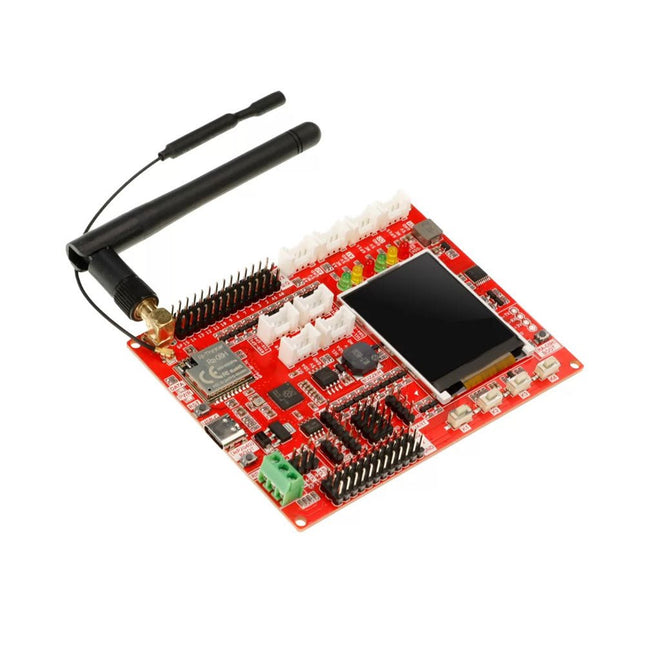
Elecrow RA-08H LoRaWAN Development Board with integrated RP2040 and 1.8" LCD (EU868)
Lora technology and Lora devices have been widely used in the field of the Internet of Things (IoT), and more and more people are joining and learning Lora development, making it an indispensable part of the IoT world. To help beginners learn and develop Lora technology better, a Lora development board has been designed specifically for beginners, which uses RP2040 as the main control and is equipped with the RA-08H module that supports Lora and LoRaWAN protocols to help users realize development. RP2040 is a dual-core, high-performance, and low-power ARM Cortex-M0+ architecture chip, suitable for IoT, robots, control, embedded systems, and other application fields. RA-08H is made from the Semtech-authorized ASR6601 RF chip, which supports the 868 MHz frequency band, has a 32 MHz MCU built-in, which has more powerful functions than ordinary RF modules, and also supports AT command control. This board retains various functional interfaces for development, such as the Crowtail interface, the common PIN to PIN header that leads out GPIO ports, and provides 3.3 V and 5 V outputs, suitable for the development and use of commonly used sensors and electronic modules on the market. In addition, the board also reserves RS485 interface, SPI, I²C, and UART interfaces, which can be compatible with more sensors/modules. In addition to the basic development interfaces, the board also integrates some commonly used functions, such as a buzzer, a custom button, red-yellow-green three-color indicator lights, and a 1.8-inch SPI interface LCD screen with a resolution of 128x160. Features Uses RP2040 as the main controller, with two 32-bit ARM Cortex M0+ processor cores (dual-core), and provides more powerful performance Integrates the RA-08H module with 32 MHz MCU, supports the 868 MHz frequency band and AT command control Abundant external interface resources, compatible with Crowtail series modules and other common interface modules on the market Integrates commonly used functions like buzzer, LED light, LCD display and custom button, making it more concise and convenient when creating projects Onboard 1.8-inch 128x160 SPI-TFT-LCD, ST7735S driver chip Compatible with Arduino/Micropython, easy to carry out different projects Specifications Main Chip Raspberry Pi RP2040, built-in 264 KB SRAM, onboard 4 MB Flash Processor Dual Core Arm Cortex-M0+ @ 133 MHz RA-08H Frequency band 803-930 MHz RA-08H Interface External antenna, SMA interface or IPEX first-generation interface LCD Display Onboard 1.8-inch 128x160SPI-TFT-LCD LCD Resolution 128x160 LCD Driver ST7735S (4-wire SPI) Development environment Arduino/MicroPython Interfaces 1x passive buzzer 4x user-defined buttons 6x programmable LEDs 1x RS485 communication interface 8x 5 V Crowtail interfaces (2x analog interfaces, 2x digital interfaces, 2x UART, 2x I²C) 12x 5 V universal pin header IO 14x 3.3 V universal pin header IO 1x 3.3 V/5 V switchable SPI 1x 3.3 V/5 V switchable UART 3x 3.3 V/5 V switchable I²C Working input voltage USB 5 V/1 A Operating temperature -10°C ~ 65°C Dimensions 102 x 76.5 mm (L x W) Included 1x Lora RA-08H Development Board 1x Lora Spring Antenna (868 MHz) 1x Lora Rubber Antenna (868 Mhz) Downloads Wiki
-

LILYGO LILYGO T-Display-GD32 RISC-V Development Board
The LILYGO TTGO T-Display-GD32 is a compact and minimalist development board featuring a powerful GD32VF103CBT6 RISC-V microcontroller. Ideal for IoT applications, wearables, and rapid prototyping, it provides versatile connectivity options like GPIO, SPI, UART, and I²C interfaces. Thanks to its efficient RISC-V architecture and clear, high-quality screen, this board is perfect for small projects requiring graphical interfaces or data visualization in a space-saving form factor. Specifications Chipset GD32VF103CBT6 FLASH 128 kB SRAM 32 kB On-board clock 108 MHz crystal oscillator Working Voltage 2.7-3.6 V Button BOOT - RESET LCD ST7789 1.14" IPS 240 x 135 USB to TTL CP2104 Modular interface TIMER, UART, SPI, I²C, PWM, ADC, DAC, CAN, USBOTG Working Temperature Range −40~85°C Peripheral Button, RGB LED, SD slot, LCD Power Supply Input USB 5 V @ 1 A Charging Current 500 mA Battery Input 3.7-4.2 V USB USB-C Dimensions 51.49 x 25.2 x 10 mm Weight 10 g Downloads GitHub
-
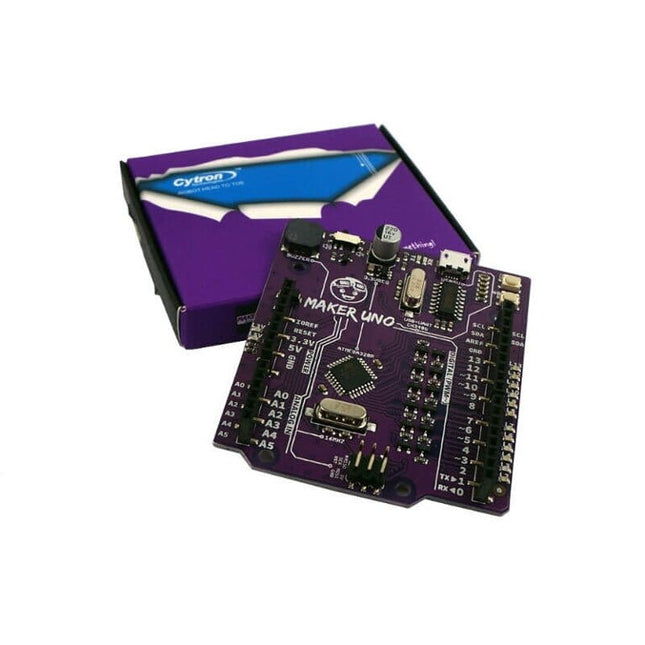
Cytron Cytron Maker Uno
Features Piezo Buzzer: Acts as a simple audio output Micro USB Port Programmable Button 12 x LED: Provides visual output on board Specifications Microcontroller ATmega328P Programming IDE Arduino IDE Operating Voltage 5 V Digital I/O 20 PWM 6 Analog Input 6 (10-bit) UART 1 SPI 1 I2C 1 External Interrupt 2 Flash Memory 32 KB SRAM 2 KB EEPROM / Data Flash 1 KB Clock Speed 16 MHz DC Current I/O Pin 20 mA Power Supply USB only DC Current for 5 V USB Source DC Current for 3.3 V 500 mA USB to Serial Chip CH340G Programmable LED 12 at digital Pin 2 to 13 Programmable Push Button 1 at digital Pin 2 Piezo Buzzer 1 at digital Pin 8 Arduino vs Maker Uno
€ 14,95
Members € 13,46
-

JOY-iT JOY-iT Nano V3
The Arduino Nano is a complete Arduino-compatible single board computer that can be plugged directly into a 32-pin socket, a breadboard or a corresponding carrier board. It offers the complete Arduino functionality in very compact dimensions. Via the micro-USB socket, you can supply the board and circuit with power as well as conveniently transfer new programs to the controller. Technical details Pin headers for direct use on the pinboard Ideal for prototyping Programmable via free Arduino IDE Connection via mini USB socket Chipset CH340G Interfaces: I²C, UART, SPI Size: 45 x 18 mm Microcontroller ATmega328P-AU Operating Voltage 5 V Flash Memory 32 KB (2 KB used for Bootloader) SRAM 2 KB EEPROM 1 KB Digital Pins 22 (6 with PWM) Analog Pins 8 DC Current per I/O Pin 40 mA Input Voltage 7-12 V Downloads Datasheet User Guide
-

Pinecone Pinecone BL602 Evaluation Board
Features Build in USB to Serial interface Build-in PCB antenna Powered by Pineseed BL602 SoC using Pinenut model: 12S stamp 2 MB Flash USB-C connection Suitable to breadboard BIY project On board three color LEDs output Dimensions: 25.4 x 44.0 mm Note: USB cable is not included.
€ 8,95
Members identical
-

SparkFun Alchitry Au FPGA Development Board (Xilinx Artix 7)
This affordable and increasingly powerful FPGA board is a fantastic starting point into the world of FPGAs and the heart of your next project. Finally, now that SparkFun builds this board, we added a Qwiic connector for easy I²C integration! The Alchitry Au features a Xilinx Artix 7 XC7A35T-1C FPGA with over 33,000 logic cells and 256 MB of DDR3 RAM. The Au offers 102 3.3 V logic level IO pins, 20 of which can be switched to 1.8 V; Nine differential analogue inputs; Eight general-purpose LEDs; a 100 MHz on-board clock that can be manipulated internally by the FPGA; a USB-C connector to configure and power the board; and a USB to serial interface for data transfer. To make getting started even easier, all Alchitry boards have full Lucid support, a built-in library of useful components to use in your project, and a debugger! Features Artix 7 XC7A35T-1C - 33,280 logic cells 256 MB DDR3 RAM 102 IO pins (3.3 V logic level, 20 of them can be switched to 1.8 V for LVDS) Nine differential analogue inputs (One dedicated, Eight mixed with digital IO) USB-C to configure and power the board Eight general-purpose LEDs One button (typically used as a reset) 100 MHz on-board clock (can be multiplied internally by the FPGA) Powered with 5 V through USB-C port, 0.1" holes, or headers USB to serial interface for data transfer (up to 12 Mbaud) Qwiic Connector Dimensions: 65 x 45 mm Downloads Datasheet Schematic 3D Model (IGES File) Element Eagle Library
-

Nvidia NVIDIA Jetson Nano Developer Kit (B01)
Ready to start developing Artificial Intelligence (AI) applications? The NVIDIA Jetson Nano Developer Kit makes the power of modern AI accessible to makers, developers, and students. When you think of NVIDIA, you probably think about graphics cards and GPUs, and rightfully so. Nvidia's track record guarantees that the Jetson Nano has enough power to run even the most demanding of tasks. The NVIDIA Jetson Nano Developer Kit is compatible with Nvidia's JetPack SDK and enables image classification and object detection amongst many applications. Applications The NVIDIA Jetson Nano Developer Kit can run multiple neural networks in parallel for applications like: Image classification Segmentation Object detection Speech processing Specifications GPU 128-core Maxwell CPU Quad-core ARM A57 @ 1.43 GHz Memory 4 GB 64-bit LPDDR4 25.6 GB/s Storage microSD (not included) Video Encode 4K @ 30 | 4x 1080p @ 30 | 9x 720p @ 30 (H.264/H.265) Video Decode 4K @ 60 | 2x 4K @ 30 | 8x 1080p @ 30 | 18x 720p @ 30 (H.264/H.265) Camera 1 x MIPI CSI-2 DPHY lanes Connectivity Gigabit Ethernet, M.2 Key E Display HDMI 2.0 and eDP 1.4 USB 4x USB 3.0, USB 2.0 Micro-B Interfaces GPIO, I²C, I²S, SPI, UART Dimensions 100 x 80 x 29 mm Included NVIDIA Jetson Nano module and carrier board Small paper card with quick start and support information Folded paper stand Downloads JetPack SDK Documentation Tutorials Online course Wiki
-
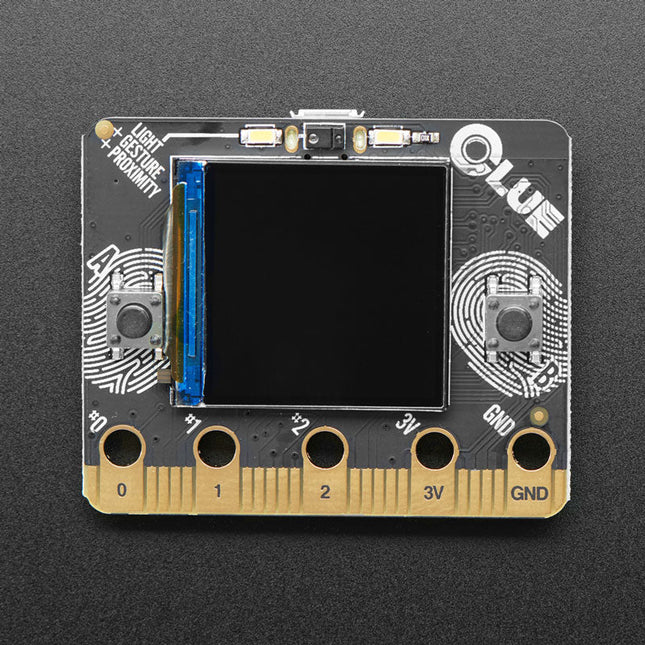
Adafruit Adafruit CLUE – nRF52840 Express with Bluetooth LE
Features Nordic nRF52840 Bluetooth LE processor – 1 MB of Flash, 256KB RAM, 64 MHz Cortex M4 processor 1.3″ 240×240 Color IPS TFT display for high-resolution text and graphics Power it from any 3-6V battery source (internal regulator and protection diodes) Two A / B user buttons and one reset button ST Micro series 9-DoF motion – LSM6DS33 Accel/Gyro + LIS3MDL magnetometer APDS9960 Proximity, Light, Color, and Gesture Sensor PDM Microphone sound sensor SHT Humidity BMP280 temperature and barometric pressure/altitude RGB NeoPixel indicator LED 2 MB internal flash storage for datalogging, images, fonts or CircuitPython code Buzzer/speaker for playing tones and beeps Two bright white LEDs in front for illumination / color sensing Qwiic / STEMMA QT connector for adding more sensors, motor controllers, or displays over I²C. You can plug in GROVE I²C sensors by using an adapter cable. Programmable with Arduino IDE or CircuitPython
-
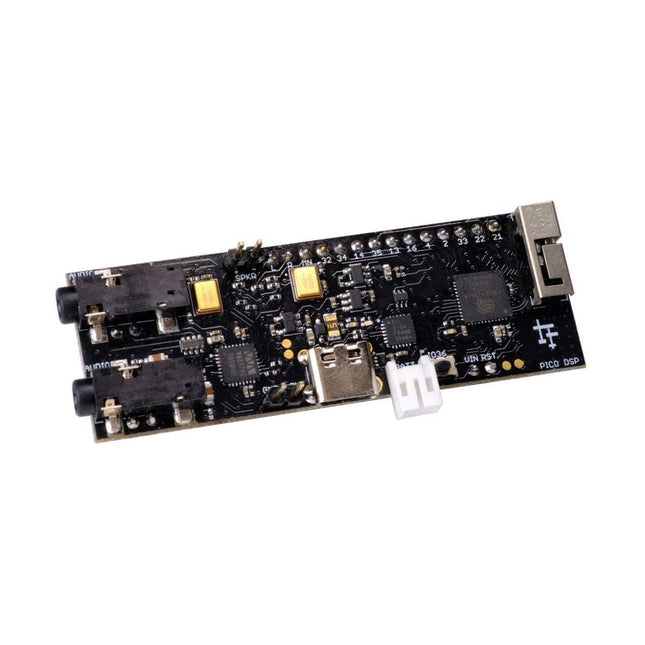
Ohmic PÚCA DSP ESP32 Development Board
PÚCA DSP is an open-source, Arduino-compatible ESP32 development board for audio and digital signal processing (DSP) applications with expansive audio-processing features. It provides audio inputs, audio outputs, a low-noise microphone array, an integrated test-speaker option, additional memory, battery-charge management, and ESD protection all on a small, breadboard-friendly PCB. Synthesizers, Installations, Voice UI, and More PÚCA DSP can be used for a wide range of DSP applications, including but not limited to those in the fields of music, art, creative technology, and adaptive technology. Music-related examples include digital-music synthesis, mobile recording, Bluetooth speakers, wireless line-level directional microphones, and the design of smart musical instruments. Art-related examples include acoustic sensor networks, sound-art installations, and Internet-radio applications. Examples related to creative and adaptive technology include voice user interface (VUI) design and Web audio for the Internet of Sounds. Compact, Integrated Design PÚCA DSP was designed for portability. When used with an external 3.7 V rechargeable battery, it can be deployed almost anywhere or integrated into just about any device, instrument, or installation. Its design emerged from months of experimentation with various ESP32 development boards, DAC breakout boards, ADC breakout boards, Microphone breakout boards, and audio-connector breakout boards, and – despite its diminutive size – it manages to provide all of that functionality in a single board. And it dos so without compromising signal quality. Specifications Processor & Memory Espressif ESP32 Pico D4 Processor 32-bit dual core 80 MHz / 160 MHz / 240 MHz 4 MB SPI Flash with 8 MB additional PSRAM (Original Edition) Wireless 2.4 GHz Wi-Fi 802.11b/g/n Bluetooth BLE 4.2 3D Antenna Audio Wolfson WM8978 Stereo Audio Codec Audio Line In on 3.5 mm stereo onnector Audio Headphone / Line Out on 3.5 mm stereo connector Stereo Aux Line In, Audio Mono Out routed to GPIO Header 2x Knowles SPM0687LR5H-1 MEMS Microphones ESD protection on all audio inputs and outputs Support for 8, 11.025, 12, 16, 22.05, 24, 32, 44.1 and 48 kHz sample rates 1 W Speaker Driver, routed to GPIO Header DAC SNR 98 dB, THD -84 dB (‘A’ weighted @ 48 kHz) ADC SNR 95 dB, THD -84 dB (‘A’ weighted @ 48 kHz) Line input impedance: 1 MOhm Line output impedance: 33 Ohm Form Factor and Connectivity Breadboard friendly 70 x 24 mm 11x GPIO pins broken out to 2.54 mm pitch header, with access to both ESP32 ADC channels, JTAG and capacitive touch pins USB 2.0 over USB Type C connector Power 3.7/4.2 V Lithium Polymer Rechargeable Battery, USB or external 5 V DC power source ESP32 and Audio Codec can be placed into low power modes under software control Battery voltage level detection ESD protection on USB data bus Downloads GitHub Datasheet Links Crowd Supply Campaign (includes FAQs) Hardware Overview Programming the Board The Audio Codec
€ 69,95€ 49,95
Members identical
-
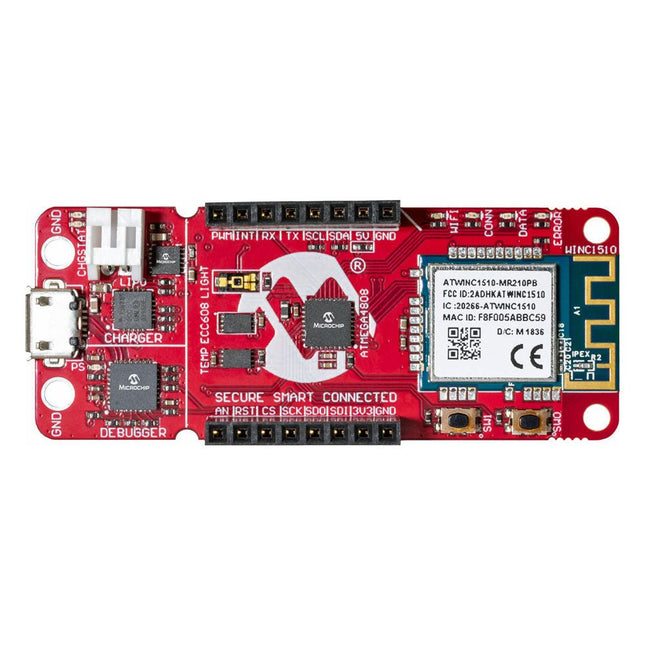
Microchip Microchip AVR-IoT WA Development Board
The AVR-IoT WA development board combines a powerful ATmega4808 AVR MCU, an ATECC608A CryptoAuthentication secure element IC and the fully certified ATWINC1510 Wi-Fi network controller – which provides the most simple and effective way to connect your embedded application to Amazon Web Services (AWS). The board also includes an on-board debugger, and requires no external hardware to program and debug the MCU. Out of the box, the MCU comes preloaded with a firmware image that enables you to quickly connect and send data to the AWS platform using the on-board temperature and light sensors. Once you are ready to build your own custom design, you can easily generate code using the free software libraries in Atmel START or MPLAB Code Configurator (MCC). The AVR-IoT WA board is supported by two award-winning Integrated Development Environments (IDEs) – Atmel Studio and Microchip MPLAB X IDE – giving you the freedom to innovate with your environment of choice. Features ATmega4808 microcontroller Four user LED’s Two mechanical buttons mikroBUS header footprint TEMT6000 Light sensor MCP9808 Temperature sensor ATECC608A CryptoAuthentication™ device WINC1510 WiFi Module On-board Debugger Auto-ID for board identification in Atmel Studio and Microchip MPLAB X One green board power and status LED Programming and debugging Virtual COM port (CDC) Two DGI GPIO lines USB and battery powered Integrated Li-Ion/LiPo battery charger
€ 39,95€ 29,95
Members identical
-
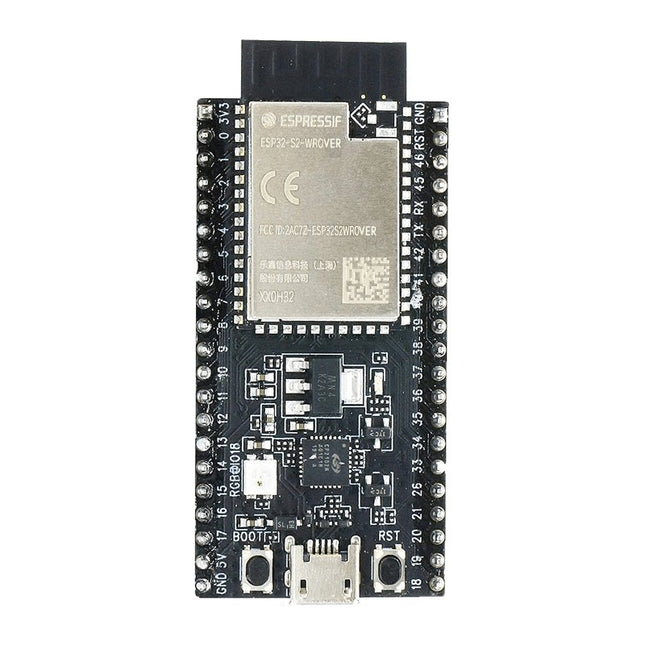
Espressif ESP32-S2-Saola-1R Development Board
ESP32-S2-Saola-1R is a small-sized ESP32-S2 based development board. Most of the I/O pins are broken out to the pin headers on both sides for easy interfacing. Developers can either connect peripherals with jumper wires or mount ESP32-S2-Saola-1R on a breadboard.ESP32-S2-Saola-1R is equipped with the ESP32-S2-WROVER module, a powerful, generic Wi-Fi MCU module that has a rich set of peripherals. It is an ideal choice for a wide variety of application scenarios relating to Internet of Things (IoT), wearable electronics and smart home. The board a PCB antenna and features a 4 MB external SPI flash and an additional 2 MB SPI Pseudo static RAM (PSRAM).FeaturesMCU ESP32-S2 embedded, Xtensa® single-core 32-bit LX7 microprocessor, up to 240 MHz 128 KB ROM 320 KB SRAM 16 KB SRAM in RTC WiFi 802.11 b/g/n Bit rate: 802.11n up to 150 Mbps A-MPDU and A-MSDU aggregation 0.4 µs guard interval support Center frequency range of operating channel: 2412 ~ 2484 MHz Hardware Interfaces: GPIO, SPI, LCD, UART, I²C, I²S, Camera interface, IR, pulse counter, LED PWM, TWAI (compatible with ISO 11898-1), USB OTG 1.1, ADC, DAC, touch sensor, temperature sensor 40 MHz crystal oscillator 4 MB SPI flash Operating voltage/Power supply: 3.0 ~ 3.6 V Operating temperature range: –40 ~ 85 °C Dimensions: 18 × 31 × 3.3 mm Applications Generic Low-power IoT Sensor Hub Generic Low-power IoT Data Loggers Cameras for Video Streaming Over-the-top (OTT) Devices USB Devices Speech Recognition Image Recognition Mesh Network Home Automation Smart Home Control Panel Smart Building Industrial Automation Smart Agriculture Audio Applications Health Care Applications Wi-Fi-enabled Toys Wearable Electronics Retail & Catering Applications Smart POS Machines
€ 22,95
Members € 20,66
-

SparkFun SparkFun RedBoard Qwiic
The SparkFun RedBoard Qwiic is an Arduino-compatible board that combines features of different Arduinos with the Qwiic Connect System. Features ATmega328 microcontroller with Optiboot Bootloader R3 Shield Compatible CH340C Serial-USB Converter 3.3 V to 5 V Voltage Level Jumper A4 / A5 Jumpers AP2112 Voltage Regulator ISP Header Input voltage: 7 V - 15 V 1 Qwiic Connector 16 MHz Clock Speed 32 k Flash Memory All SMD Construction Improved Reset Button
€ 27,95€ 19,95
Members identical
-
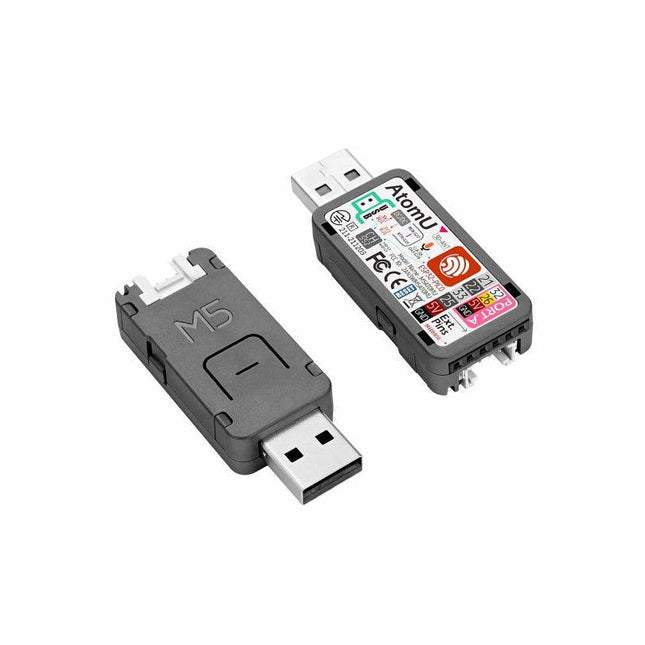
M5Stack M5Stack AtomU ESP32 Development Kit with USB-A
ATOM U is a compact low-power consumption speech recognition IoT development kit. It adopts an ESP32 chipset, equipped with 2 low-power Xtensa 32-bit LX6 microprocessors with the main frequency of up to 240 MHz. Built-in USB-A interface, IR emitter, programmable RGB LED. Plug-and-play, easy to upload and download programs. Integrated Wi-Fi and digital microphone SPM1423 (I2S) for the clear sound record. suitable for HMI, Speech-to-Text (STT). Low-code development ATOM U supports UIFlow graphical programming platform, scripting-free, cloud push; Fully compatible with Arduino, MicroPython, ESP32-IDF, and other mainstream development platforms, to quickly build various applications. High integration ATOM U contains a USB-A port for programming/power supply, IR emitter, programmable RGB LED x1, button x1; Finely tuned RF circuit, providing stable and reliable wireless communication. Strong expandability ATOM U is easy access to M5Stack's hardware and software system. Features ESP32-PICO-D4 (2.4GHz Wi-Fi dual mode) Integrated programmable RGB LED and button Compact design Built-in IR emitter Expandable pinout and GROVE port Development platform: UIFlow MicroPython Arduino Specifications ESP32-PICO-D4 240MHz dual core, 600 DMIPS, 520KB SRAM, 2.4G Wi-Fi Microphone SPM1423 Microphone sensitivity 94 dB SPL@1 KHz Typical value: -22 dBFS Microphone signal-to-noise ratio 94 dB SPL@1 KHz, A-weighted Typical value: 61.4 dB Standby working current 40.4 mA Support input sound frequency 100 Hz ~ 10 KHz Support PDM clock frequency 1.0 ~ 3.25 MHz Weight 8.4 g Product size 52 x 20 x 10 mm Downloads Documentation
€ 19,95€ 14,95
Members identical
-
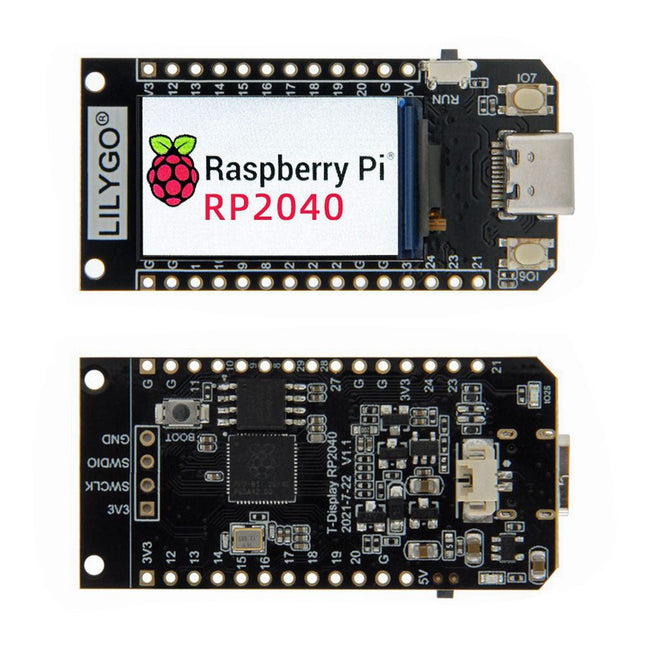
LILYGO LILYGO T-Display RP2040 Development Board
LILYGO T-Display RP2040 Raspberry Pi Module 1.14-inch LCD Development Board This board is based on a Raspberry Pi Pico RP2040 with Dual Cortex-M0+ and 4 MB Flash memory. It is equipped with a 1.14-inch full color IPS display. The ST7789V display has a resolution of 135 x 240 pixels and is connected via the SPI interface. Specifications MCU RP2040 Dual ARM Cortex M0+ Flash 4 MB Bus interfaces 2x UART, 2x SPI, 2x I²C, 6x PWM Programming language C/C++, MicroPython Support machine learning library TensorFlow Lite Onboard functions Buttons: IO06+IO07, battery power detection TFT Display 1.14-inch ST7789V IPS LCD Resolution 135 x 240, full color Interface 4-Wire SPI interface Operating temperature -20°C ~ +70°C Working power supply 3.3 V Connector JST-GH 1.25 mm 2-pin Included LILYGO T-Display RP2040 Unsoldered headers JST cable Downloads Pinout GitHub
-
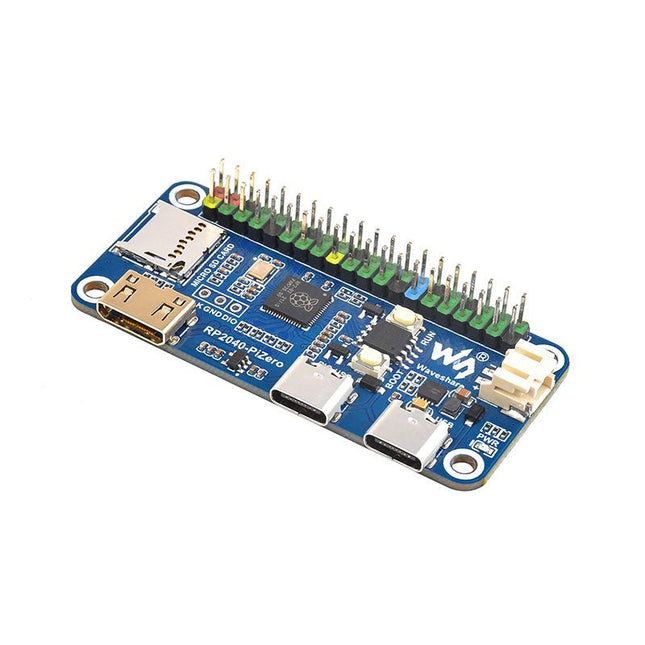
Waveshare Waveshare RP2040-PiZero Development Board
Waveshare RP2040-PiZero is a high-performance and cost-effective microcontroller board with onboard DVI interface, TF card slot and PIO-USB port, compatible with Raspberry Pi 40-pin GPIO header, easy to develop and integrate into the products. Features RP2040 microcontroller chip designed by Raspberry Pi Dual-core ARM Cortex M0+ processor, flexible clock running up to 133 MHz 264 KB of SRAM, and 16 MB of onboard Flash memory Onboard DVI interface can drive most HDMI screens (DVI compatibility required) Supports using as a USB host or slave via onboard PIO-USB port Onboard TF card slot for reading and writing TF card Onboard Lithium battery recharge/discharge header, suitable for mobile scenarios USB 1.1 with device and host support Drag-and-drop programming using mass storage over USB Low-power sleep and dormant modes 2x SPI, 2x I²C, 2x UART, 4x 12-bit ADC, 16x controllable PWM channels Accurate clock and timer on-chip Temperature sensor Accelerated floating-point libraries on-chip Downloads Wiki
€ 17,95
Members € 16,16
-

LILYGO LILYGO T-Journal ESP32 Camera Module Development Board (Normal Lens)
The T-Journal is a cheap ESP32 Camera Development Board that features an OV2640 camera, an antenna, a 0.91-inch OLED display, some exposed GPIOs, and a micro-USB interface. It makes it easy and quick to upload code to the board. Specifications Chipset Expressif-ESP32-PCIO-D4 240 MHz Xtensa single-/dual-core 32-bit LX6 microprocessor FLASH QSPI flash/SRAM, up to 4x 16 MB SRAM 520 kB SRAM KEY reset, IO32 Display 0.91' SSD1306 Power indicator lamp red USB to TTL CP2104 Camera OV2640, 2 Megapixel Steering engine analog servo On-board clock 40 MHz crystal oscillator Working voltage 2.3-3.6 V Working current about 160 mA Working temperature range -40℃ ~ +85℃ Size 64.57 x 23.98 mm Power Supply USB 5 V/1 A Charging current 1 A Battery 3.7 V lithium battery WiFi Standard FCC/CE/TELEC/KCC/SRRC/NCC (ESP32-chip) Protocol 802.11 b/g/n/e/i (802.11n, speed up to 150 Mbps) A-MPDU and A-MSDU polymerization, support 0.4 μS Protection interval Frequency range 2.4 GHz~2.5 GHz (2400 M ~ 2483.5 M) Transmit Power 22 dBm Communication distance 300m Bluetooth Protocol meet bluetooth v4.2BR/EDR and BLE standard Radio frequency with -98 dBm sensitivity NZIF receiver Class-1, Class-2 & Class-3 emitter AFH Audio frequency CVSD & SBC audio frequency Software Wifi Mode Station/SoftAP/SoftAP+Station/P2P Security mechanism WPA/WPA2/WPA2-Enterprise/WPS Encryption Type AES/RSA/ECC/SHA Firmware upgrade UART download/OTA(Through network/host to download and write firmware) Software Development Support cloud server development /SDK for user firmware development Networking protocol IPv4, IPv6, SSL, TCP/UDP/HTTP/FTP/MQTT User Configuration AT + Instruction set, cloud server, Android/iOS app OS FreeRTOS Included 1x ESP32 Camera Module (Normal Lens) 1x Wi-Fi Antenna 1x Power Line Downloads Camera library for Arduino
-
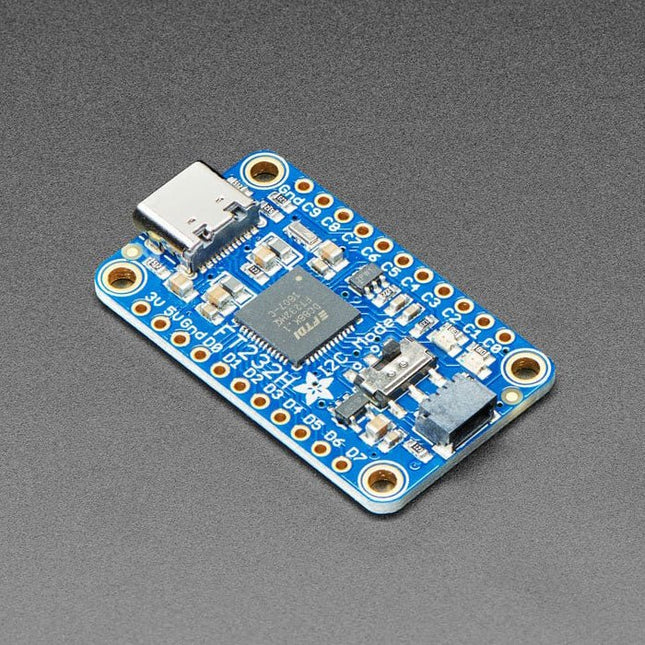
Adafruit Adafruit FT232H Breakout (USB to GPIO, SPI, I²C)
Wouldn't it be cool to drive a tiny OLED display, read a color sensor, or even just flash some LEDs directly from your computer? Sure you can program an Arduino or Trinket to talk to these devices and your computer, but why can't your computer just talk to those devices and sensors itself? Well, now your computer can talk to devices using the Adafruit FT232H breakout board! What can the FT232H chip do? This chip from FTDI is similar to their USB to serial converter chips but adds a 'multi-protocol synchronous serial engine' which allows it to speak many common protocols like SPI, I²C, serial UART, JTAG, and more! There's even a handful of digital GPIO pins that you can read and write to do things like flash LEDs, read switches or buttons, and more. The FT232H breakout is like adding a little swiss army knife for serial protocols to your computer! This chip is powerful and useful to have when you want to use Python (for example) to quickly iterate and test a device that uses I²C, SPI or plain general purpose I/O. There's no firmware to deal with, so you don't have to deal with how to 'send data to and from an Arduino which is then sent to and from' an electronic sensor or display or part. This breakout has an FT232H chip and an EEPROM for onboard configuration. Specifications Dimensions: 23 x 38 x 4 mm (0.9 x 1.5 x 0.2') Weight: 3.4 g Downloads CAD Files
-

Espressif ESP32-S2-Saola-1M Development Board
ESP32-S2-Saola-1M is a small-sized ESP32-S2 based development board. Most of the I/O pins are broken out to the pin headers on both sides for easy interfacing. Developers can either connect peripherals with jumper wires or mount ESP32-S2-Saola-1M on a breadboard. ESP32-S2-Saola-1M is equipped with the ESP32-S2-WROOM module, a powerful, generic Wi-Fi MCU module that has a rich set of peripherals. It is an ideal choice for a wide variety of application scenarios relating to Internet of Things (IoT), wearable electronics and smart home. The board a PCB antenna and features a 4 MB external SPI flash. Features MCU ESP32-S2 embedded, Xtensa® single-core 32-bit LX7 microprocessor, up to 240 MHz 128 KB ROM 320 KB SRAM 16 KB SRAM in RTC WiFi 802.11 b/g/n Bit rate: 802.11n up to 150 Mbps A-MPDU and A-MSDU aggregation 0.4 µs guard interval support Center frequency range of operating channel: 2412 ~ 2484 MHz Hardware Interfaces: GPIO, SPI, LCD, UART, I²C, I²S, Camera interface, IR, pulse counter, LED PWM, TWAI (compatible with ISO 11898-1), USB OTG 1.1, ADC, DAC, touch sensor, temperature sensor 40 MHz crystal oscillator 4 MB SPI flash Operating voltage/Power supply: 3.0 ~ 3.6 V Operating temperature range: –40 ~ 85 °C Dimensions: 18 × 31 × 3.3 mm Applications Generic Low-power IoT Sensor Hub Generic Low-power IoT Data Loggers Cameras for Video Streaming Over-the-top (OTT) Devices USB Devices Speech Recognition Image Recognition Mesh Network Home Automation Smart Home Control Panel Smart Building Industrial Automation Smart Agriculture Audio Applications Health Care Applications Wi-Fi-enabled Toys Wearable Electronics Retail & Catering Applications Smart POS Machines
-

Farnell element14 OKdo E1 Development Board
The OKdo E1 is an ultra-low-cost Development Board based on the NXP LPC55S69JBD100 dual-core Arm Cortex-M33 microcontroller. The E1 board is perfect for Industrial IoT, building control and automation, consumer electronics, general embedded and secure applications. Features Processor with Arm TrustZone, Floating Point Unit (FPU) and Memory Protection Unit (MPU) CASPER Crypto co-processor to enable hardware acceleration for certain asymmetric cryptographic algorithms PowerQuad Hardware Accelerator for fixed and floating point DSP functions SRAM Physical Unclonable Function (PUF) for key generation, storage and reconstruction PRINCE module for real-time encryption and decryption of flash data AES-256 and SHA2 engines Up to Nine Flexcomm interfaces. Each Flexcomm interface can be selected by software to be a USART, SPI, I²C, and I²S interface USB 2.0 High-Speed Host/Device controller with on-chip PHY USB 2.0 Full-Speed Host/Device controller with on-chip PHY Up to 64 GPIOs Secure digital input/output (SD/MMC and SDIO) card interface Specifications LPC55S69JBD100 640kbyte flash microcontroller In-built CMSIS-DAP v1.0.7 debugger based on LPC11U35 Internal PLL support up to 100MHz operation, 16MHz can be mounted for full 150MHz operation. SRAM 320kB 32kHz crystal for real-time clock 4 user switches 3-colour LED User USB connector 2-off 16-way expansion connectors UART over USB virtual COM port
€ 24,95
Members € 22,46
-
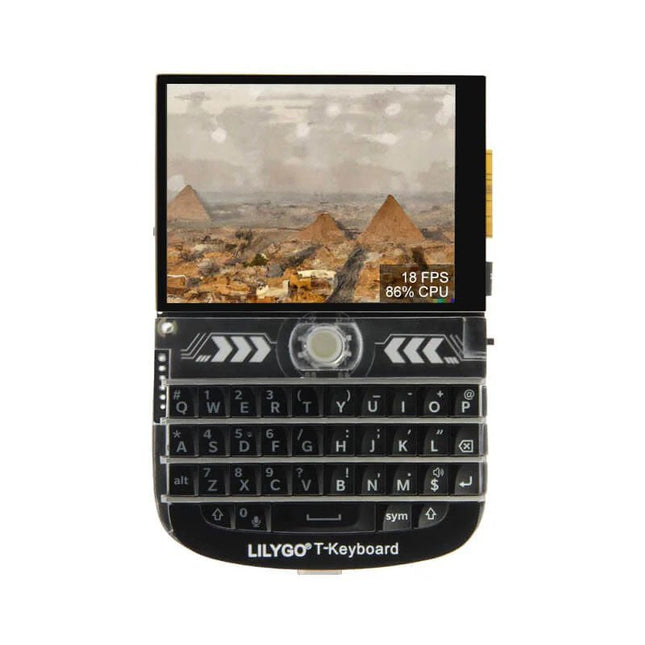
LILYGO LILYGO T-Deck ESP32-S3 LoRa Development Board
The T-Deck is a pocket-sized gadget featuring a 2.8-inch IPS LCD display (320 x 240), a mini keyboard, and an ESP32 dual-core processor. While it’s not quite a smartphone, it offers plenty of potential for tech enthusiasts. With some programming know-how, you can transform it into a standalone messaging device or a portable coding platform. Specifications Microcontroller ESP32-S3FN16R8 Dual-core LX7 microprocessor Wireless Connectivity 2.4 GHz Wi-Fi & Bluetooth 5 (LE) Development Arduino, PlatformlO, MicroPython Flash 16 MB PSRAM 8 MB Battery ADC Pin IO04 Onboard functions Trackball, Microphone, Speaker Display 2.8" ST7789 SPI Interface IPS Resolution 320 x 240 (Full viewing angle) Transmit power +22 dBm SX1262 LoRa Transceiver (Frequency) 868 Mhz Dimensions 100 x 68 x 11 mm Included 1x T-Deck ESP32-S3 LoRa 1x FPC antenna (868 MHz) 1x Male pin (6-pin) 1x Power cable Downloads GitHub
-

LILYGO LILYGO T-Panel S3 Development Board
The LILYGO T-Panel S3 is a versatile development board designed for IoT applications, featuring a 4-inch IPS LCD with a 480x480 resolution. Powered by the ESP32-S3 microcontroller, it offers 2.4 GHz Wi-Fi and Bluetooth 5 (LE) connectivity, with 16 MB of flash memory and 8 MB of PSRAM. The board supports development environments such as Arduino, PlatformIO-IDE, and MicroPython. Notably, it includes a capacitive touch interface, enhancing user interaction capabilities. Onboard functions comprise Boot (IO00), Reset, and two additional keys, providing flexibility for various applications. This combination of features makes the T-Panel S3 suitable for a wide range of IoT projects and smart device control interfaces. Specifications MCU1 ESP32-S3 Flash 16 MB PSRAM 8 MB Wireless Connectivity 2.4 GHz Wi-Fi + Bluetooth 5 (LE) MCU2 ESP32-H2 Flash 4 MB Wireless Connectivity IEEE 802.15.4 + Bluetooth 5 (LE) Developing Arduino, PlatformIO-IDE, Micropython Display 4.0" 480x480 IPS ST7701S LCD Resolution 480 x 480 (RGB) Interface SPI + RGB Compatibility library Arduino_ GFX, LVGL Onboard functions QWiiCx2 + TF Card + AntennaESP32 4x Button= S3(Boot + RST) + H2(Boot + RST) Transceiver Module RS485 Using bus communication protocol UART Included 1x T-Panel S3 1x Female pin (2x 8x1.27) Downloads GitHub
-

Espressif ESP32-S3-EYE
ESP32-S3-EYE is a small-sized AI development board. It is based on the ESP32-S3 SoC and ESP-WHO, Espressif’s AI development framework. The ESP32-S3-EYE board consists of two parts: the main board (ESP32-S3-EYE-MB) features the ESP32-S3-WROOM-1 module, a 2-Megapixel camera, a SD card slot, a digital microphone, a USB port, and function buttons; and the sub board (ESP32-S3-EYE-SUB) integrates an LCD display. The main board and sub board are connected through pin headers. ESP32-S3-EYE offers plenty of storage, with an 8 MB Octal PSRAM and a 8 MB flash. It also supports image transmission via Wi-Fi and debugging through a Micro-USB port. Specifications Camera The 2 MP camera OV2640 has a 66.5° field of view and a maximum resolution of 1600x1200. You can change the resolution when developing applications. Module Power LED The LED (green) turns on when USB power is connected to the board. If it is not turned on, it indicates either the USB power is not supplied, or the 5 V to 3.3 V LDO is broken. Software can configure GPIO3 to set different LED statuses (turned on/off, flashing) for different statuses of the board. Note: GPIO3 must be set up in open-drain mode. Pulling GPIO3 up may burn the LED. Pin Headers Connect the female headers on the sub board. 5 V to 3.3 V LDO Power regulator that converts a 5 V supply into a 3.3 V output for the module. Digital Microphone The digital I²S MEMS microphone features 61 dB SNR and –26 dBFS sensitivity, working at 3.3 V. FPC Connector Connects the main board and the sub board. Function Button There are six function buttons on the board. Users can configure any functions as needed except for the RST button. ESP32-S3-WROOM-1 The ESP32-S3-WROOM-1 module embeds the ESP32-S3R8 chip variant that provides Wi-Fi and Bluetooth 5 (LE) connectivity, as well as dedicated vector instructions for accelerating neural network computing and signal processing. On top of the integrated 8 MB Octal SPI PSRAM offered by the SoC, the module also comes with 8 MB flash, allowing for fast data access. ESP32-S3-WROOM-1U module is also supported. MicroSD Card Slot Used for inserting a MicroSD card to expand memory capacity. 3.3 V to 1.5 V LDO Power regulator that converts a 3.3 V supply into a 1.5 V output for the camera. 3.3 V to 2.8 V LDO Power regulator that converts a 3.3 V supply into a 2.8 V output for the camera. USB Port A Micro-USB port used for 5 V power supply to the board, as well as for communication with the chip via GPIO19 and GPIO20. Battery Soldering Points Used for soldering a battery socket to connect an external Li-ion battery that can serve as an alternative power supply to the board. If you use an external battery, make sure it has built-in protection circuit and fuse. The recommended specifications of the battery: capacity > 1000 mAh, output voltage 3.7 V, input voltage 4.2 V – 5 V. Battery Charger Chip 1 A linear Li-ion battery charger (ME4054BM5G-N) in ThinSOT package. The power source for charging is the USB Port. Battery Red LED When the USB power is connected to the board and a battery is not connected, the red LED blinks. If a battery is connected and being charged, the red LED turns on. When the battery is fully charged, it turns off. Accelerometer Three-axis accelerometer (QMA7981) for screen rotation, etc.
-

1 Bit Squared iCEBreaker FPGA Development Board
The iCEBreaker FPGA board is an open-source educational FPGA development board. The iCEBreaker is great for classes and workshops teaching the use of the open source FPGA design flow through Yosys, nextpnr, IceStorm, Icarus Verilog, Amaranth HDL and others. This means the board is low cost and has a nice set of features to allow for the design of interesting classes and workshop exercises. At the same time it allows the user to use the proprietary vendor tools if they choose to. After the workshop the boards can be easily used as a development board as most GPIO are exposed, broken out and configurable through jumpers on the back of the board. There is only a minimal amount of buttons and LED that can't be disconnected and used for your own purposes. Documentation Workshop
-

Luckfox LuckFox Pico Mini B Linux Micro Development Board (with Headers)
LuckFox Pico Mini is a compact Linux micro development board based on the Rockchip RV1103 chip, providing a simple and efficient development platform for developers. It supports a variety of interfaces, including MIPI CSI, GPIO, UART, SPI, I²C, USB, etc., which is convenient for quick development and debugging. Features Single-core ARM Cortex-A7 32-bit core with integrated NEON and FPU Built-in Rockchip self-developed 4th generation NPU, features high computing precision and supports int, int8, and int16 hybrid quantization. The computing power of int8 is 0.5 TOPS, and up to 1.0 TOPS with int4 Built-in self-developed third-generation ISP3.2, supports 4-Megapixel, with multiple image enhancement and correction algorithms such as HDR, WDR, multi-level noise reduction, etc. Features powerful encoding performance, supports intelligent encoding mode and adaptive stream saving according to the scene, saves more than 50% bit rate of the conventional CBR mode so that the images from camera are high-definition with smaller size, double the storage space Built-in RISC-V MCU supports low power consumption and fast start-up, supports 250 ms fast picture capture and loading Al model library at the same time to realize face recognition "in one second" Built-in 16-bit DRAM DDR2, which is capable of sustaining demanding memory bandwidths Integrated with built-in POR, audio codec and MAC PHY Specifications Processor ARM Cortex-A7, single-core 32-bit CPU, 1.2 GHz, with NEON and FPU NPU Rockchip 4th-gen NPU, supports int4, int8, int16; up to 1.0 TOPS (int4) ISP Third-gen ISP3.2, up to 4 MP input at 30fps, HDR, WDR, noise reduction RAM 64 MB DDR2 Storage 128 MB SPI NAND Flash USB USB 2.0 Host/Device via Type-C Camera Interface MIPI CSI 2-lane GPIO Pins 17 GPIO pins Power Consumption Low power, RISC-V MCU for fast startup Dimensions 28 x 21 mm Downloads Wiki
€ 19,95€ 9,95
Members identical























